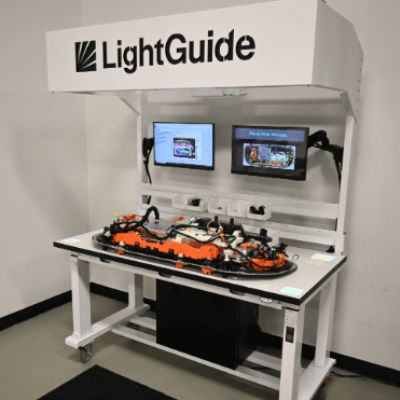 Daniel Schaeffler
Daniel SchaefflerThe More You Know
December 1, 2017Comments
Optimizing sheetmetal flow to form a stamped part requires understanding the interaction between the sheetmetal, surface characteristics and tooling. Consider where we were in the 1970s. Back then, we could choose between seven grades of sheet steel. Most of the steel used on cars did not contain a galvanized coating. Lubrication for many deep-drawn parts consisted of a paste made from animal fat. And the tooling material choices for large stampings? With apologies to Henry Ford, you can have any material you want, as long as it’s D2. If the surface wasn’t up to the desired quality, there was always Bondo and a few more layers of paint. Using just trial-and-error could produce an acceptable part, given that there were a limited number of variables to master and the fact that a threshold for “sufficient quality” took comparatively less effort to achieve.
This sounds like ancient history. But is it? Almost half of all tool-and-die workers today are more than 55 years old. When they entered the field in the mid-1980s, they apprenticed under journeymen who learned the trade in the 1970s or earlier. Ideally, these workers now have 30 yr. of good experience. Unfortunately, some of them may very well have 1 yr. of experience 30 times over, repeating the lessons learned from their teachers.
Today’s metalforming industry looks quite a bit different than the simpler times of the 1970s. We now can choose from more than 200 grades of sheet steel for automotive applications, ranging from one-half to 10 times the strength of the steels available four decades ago. Properties today can be engineered to meet the requirements of specific applications, moving away from commodity sheetmetals. Zinc-coated steels for corrosion resistance are commonplace—with some automakers choosing soft pure zinc (either hot-dip galvanized or electrogalvanized) and others using a much harder zinc-iron alloy known as galvanneal. New aluminum alloys refined over the last decade are making significant inroads in more mass-market applications, with most suppliers bringing new capacity onstream.
Class A panels for exposed applications made from these steel or aluminum alloys must exhibit consistent surface quality such that just 100 microns of paint (half of that being clearcoat) is sufficient. The choice of tooling material, with coatings and inserts as necessary, is made based on the sheetmetal, intended application and part volume. Lubricants with additives are engineered based on the contact pressures and temperatures encountered during stamping. Productivity increases and the ability to stamp difficult to form grades help justify the purchase of new servo presses.
Even with these advances, basic principles still apply. Fundamentally, sheetmetal forming involves applying energy to a flat metallic piece to deform it into the desired shape. The energy to make stamped parts transfers from a punch, where the top surface features a contour that mirrors the targeted profile. That energy transfer is a function of how the workpiece responds to deformation, the path the sheetmetal follows in reaching that desired part shape, and the interfaces between the punch and sheet as well as between the sheet and the rest of the tooling. If the energy applied to the forming system to stamp a part surpasses the amount that the forming system can handle, a split will form in the part. When this occurs, either the energy requirements in part forming must be lowered or forming-system capability must be increased. This is where the interface interaction of lubrication, tooling surfaces and radii, and sheetmetal properties all come into play.We must account for the variability inherent within the forming system. The specifications to which sheetmetals are ordered allow for a range of properties deemed to influence forming. A coil may measure more than a mile long, but we assume that mill certs taken on one sample from the coil end represent the entire batch. When we run a part and some of the stampings split, our first instinct may be to say that the sheetmetal changed, when in reality change occurred elsewhere in the forming system where we hadn’t measured—think of the unused tonnage monitors sitting in the corner of the plant. A better job of collecting meaningful information and analyzing the impact of these measurements on manufacturing results yields better anticipation and improved management of our processes, and, ultimately, greater efficiency and improved results.
With so many variables present in today’s forming system, the metalforming industry must move from trial-and-error to a science and engineering approach. Experience remains vital, but we must recognize when to incorporate new information into the problem-solving process. The industry has made great progress via computer forming and structural simulation. The ease of use of these programs masks their complexity and caveats. But, deviations from reality can occur in many places, from a material model not matched to the sheetmetal grade, to the assumption that friction is uniform throughout the stamping. Furthermore, what metal properties should we add to the model? We must account for the full range of potential properties for a given grade.
Sometimes new information isn’t necessary. We can benefit from looking at what we already have, just from a new perspective. For almost 20 years, Dr. Stuart Keeler has shared his knowledge and experience with the readers of MetalForming and the attendees of the Precision Metalforming Association’s conferences. He has helped the sheetmetal-forming industry move from knowing how a part is formed to understanding why the sheetmetal behaved in a predictable manner and how to use this knowledge to make a better product. With Dr. Keeler’s retirement, I’m attempting to follow in his path, and I can only hope to make a similar impact on our community. I look forward to sharing my perspective with you, and look forward to your comments, questions, critiques and criticisms. MF
View Glossary of Metalforming Terms
See also: Engineering Quality Solutions, Inc., 4M Partners, LLC
Technologies: Management, Materials, Training
Comments
Must be logged in to post a comment. Sign in or Create an Account
There are no comments posted. Training
TrainingAR Work-Instruction Workstation for Manufacturing-Related Pr...
Wednesday, March 22, 2023
 Training
TrainingPMA and NTMA Applaud Federal Workforce Development Funding
Friday, August 23, 2019
 Training
TrainingWorkforce Development and PMA's METALFORM EDU, Erin Riffle, ...
Wednesday, October 31, 2018
 Podcast
Podcast 




